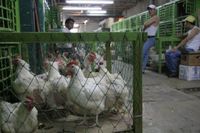On Friday, April 4, 2025, Mexican health authorities confirmed the first human case of avian influenza A (H5N1) in the country. This alarming announcement was made by the Secretaria de Salud federal (SSa), which reported that the patient is a three-year-old girl from Durango. The Instituto de Diagnóstico y Referencia Epidemiológicos (InDRE) had confirmed the positive result on April 1, 2025.
The young girl is currently hospitalized in serious condition at a medical facility in Torreón. Initially, she was being treated for suspected whooping cough at an IMSS clinic in Gómez Palacio before being transferred to the Unidad Médica de Alta Especialidad (UMAE) No. 71 in Torreón. According to the IMSS, the girl received treatment with oseltamivir, an antiviral medication.
In light of this first confirmed case, the SSa has activated emergency protocols and notified the World Health Organization (WHO), adhering to the regulations set forth in the International Health Regulations. The Secretaría de Salud de Durango has implemented a sanitary fence around the girl's home and initiated testing for nearby residents to monitor any potential spread of the virus.
The symptoms of avian influenza can vary widely, ranging from mild respiratory issues to severe complications. In the case of this young girl, health officials have noted symptoms including high fever (over 38 °C), general malaise, cough, sore throat, and muscle pain. More severe manifestations can include conjunctivitis, severe respiratory problems, and neurological disorders such as altered mental state or seizures.
Avian influenza, primarily affecting birds, is caused by a virus from the Orthomyxoviridae family. The virus can be classified as low pathogenic or highly pathogenic, with the latter being responsible for severe disease and high mortality rates among birds. While most avian influenza viruses do not infect humans, certain strains, particularly H5 and H7 subtypes, pose a significant public health threat.
According to the Pan American Health Organization (OPS), human infections with A(H5N1) have been reported in the Americas, with a total of 70 cases documented, primarily in the United States. Other cases have been reported in Ecuador, Chile, and Canada, with one death associated with the infection in the U.S. These infections typically occur after close contact with infected birds or contaminated environments.
The transmission of avian influenza to humans generally occurs through direct contact with infected birds, their droppings, or environments contaminated by the virus. Risk factors include handling infected birds, exposure to surfaces tainted with their droppings, and consuming undercooked poultry products.
To prevent the spread of avian influenza, health authorities recommend avoiding direct contact with wild birds and poultry, using personal protective equipment when handling birds, and ensuring proper cooking of poultry and eggs. The current case highlights the importance of vigilance in monitoring avian influenza, especially in areas where birds are raised or where wild birds are present.
In response to the confirmed case, the federal health department has begun training health personnel in Durango and Coahuila about the national guide for preparing for and responding to zoonotic influenza outbreaks. Additionally, the Secretaría de Medio Ambiente y Recursos Naturales (Semarnat) is conducting biological sampling of wild and synanthropic birds in the vicinity of the positive case's home.
As authorities continue to monitor the situation, the Secretaría de Agricultura federal and Desarrollo Rural, through the Servicio Nacional de Sanidad, Inocuidad y Calidad Agroalimentaria (Senasica), reported that no commercial production units have been affected by avian influenza A(H5N1) in Mexico. They are actively conducting epidemiological surveillance to identify any potential cases that may arise.
This first human case of avian influenza in Mexico raises significant concerns about public health and the potential for further transmission. The health authorities are taking proactive measures to contain the situation and ensure the safety of the surrounding community.
As the investigation continues, the health department urges the public to remain informed about the symptoms and transmission of avian influenza. Awareness and education are crucial in preventing further cases and protecting public health.
The implications of this case extend beyond the immediate health risks. It serves as a reminder of the ongoing threat posed by zoonotic diseases and the importance of robust public health systems in managing such outbreaks. The collaboration between health authorities, environmental agencies, and the community will be essential in navigating this challenge.
In conclusion, the confirmation of the first human case of avian influenza A (H5N1) in Mexico is a critical development that requires immediate attention and action from health authorities and the public alike. Vigilance, education, and swift response measures will be key to preventing the spread of this potentially deadly virus.



